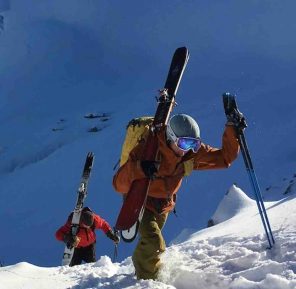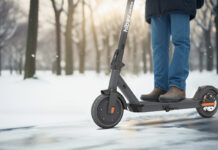 I might still be in flip flops, but as soon as the temperature drops outside, my husband starts pulling out everyone’s skis and snowboards to get them ready for another season.
I might still be in flip flops, but as soon as the temperature drops outside, my husband starts pulling out everyone’s skis and snowboards to get them ready for another season.
He’s a sales rep for a ski company so it’s no surprise that he’s getting his skis ready for winter, but he’d be the first to tell you that there’s a lot more to spending time on the slopes than having waxed and tuned ski gear. You have to do a little personal tuning too.
The key to having a great season on the snow is stretching and toning those muscles long before the snow falls, because even if you’re an advanced skier or boarder, that first day on the slopes can hit you like a ton of bricks.
Take ski boots for example: I’ve always thought that ski boots were a form of a medieval torture device. That’s because after spending a few hours in them, I’m unable to walk for at least two days after. Maybe if I had spent a few weeks before my first day working those muscles and focusing on my legs, I might not have had so many issues.
Shin splints, numb feet, and strained muscles are just a few of the problems I’ve run into, but the thing with skiing and snowboarding is that it works out every muscle. I know people who couldn’t reach over their shoulder to scratch their back because they were so sore after their first few days on the slopes, and although an après ski hot tub can soothe sore muscles, it’s no replacement for preparing your body in the first place.
I have no desire to experience that level of soreness again this year, and that’s why October is the perfect month to start getting ready for ski season. Most local hills around here open at the end of November/beginning of December, so you have 6 weeks to prepare your body for your first day on the snow.
Because of my husband’s job, I’m lucky to have access to some of the most enthusiastic skiers and boarders in British Columbia. They gave me some tips you can use to get in shape before the 2016/2017 ski season.
Strength training
It sounds like simple advice, but most advanced skiers will tell you that you need to do a lot of strength training in the build up to a new season. Having conditioned muscles in your arms, legs, and glutes will ensure you don’t feel that first-day-soreness you would if you hadn’t worked out.
One of the reasons why I’m always reluctant to put in the workout time before ski season is because I don’t like the gym. I’ve had memberships that I’ve let lapse on many occasions, so I know that if I’m going to do strength training, I’m going to do that at home.
Thankfully, there are a lot of different ways you can build up your muscles without leaving your house. If you’ve got the space you can bring home a Weider Pro 256 Bench with weights to work out your arms, legs, shoulder, and back.
Some people don’t have room for a full weight bench, so I’ve had the Gold’s Gym door gym recommended to me. It gives you a full body workout, but it hangs on your door and is compact enough to just slide under the bed when you need to store it.
Focus on your core
I know, I know, people talk about building up their core all the time, but having a strong core really does help you with skiing. It protects you from injury, makes you feel less sore overall, and ensures you can stand up to a full day on the slopes.
There are a lot of different core exercises that are great for skiing. Planks, done by holding yourself in a halfway pushup position, strengthen your core, and you can do a variety of planks to get in shape for ski season. One of my favourite is a stability ball plank. If you have a stability ball you can do different stability ball planks to strengthen your core.
Improve your flexibility
Yoga has always been a big deal on the west coast, but it gets really popular before the snow flies. By doing yoga poses you pull and stretch muscles you probably haven’t used in a while, and that constant stretching will improve your flexibility and get everything toned up before you strap on your ski or snowboard boots.
You don’t have to go out to do Yoga: all you need is a yoga mat and your tablet or smartphone and you can work your way through a yoga routine every day.
Throw in a bit of cardio too
One of my favourite things to do in fall is head outside for a run. The leaves are falling, the air is crisp and cool, and you can get in a great workout that leaves you full of energy all day long. The only problem will fall running is that you don’t really have a goal like you would if you want to look good in a bathing suit in the summer.
Why not focus your fall run on getting in shape for ski season? By adding a few days of running to your weekly workouts, every other exercise you do will become easier. To keep motivated I highly recommend having a fitness wearable like the Fitbit Charge 2. It has multi-sport modes so you can track everything you do, from running to biking to skiing, and you’ll be able to stay in the zone thanks to heart rate monitoring.
If you spend the next six weeks focusing on improving your core and your strength and flexibility, you’ll be able to skip the soreness during your first few days on the slopes. Imagine just enjoying being out on the snow again and not having to worry about how you’ll feel the next day.
There are a lot of great products and devices on Best Buy that will help you get in shape for the 2017-ski season, so take a look and start making a plan. Once you’ve got a program established all you have to do is pray for snow. I have it on good authority that it’s right around the corner.
Main image: Bryce Anderson
Core image: www.womenshealthmag.co.uk







